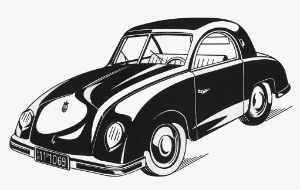|
|
| Line 1: |
Line 1: |
| − | [[File:Champion_400H.jpg]] | + | [[File:Champion_400H.png]] |
| | | | |
| | '''Champion 400. 1951–4 (prod. 4,000 approx.). 2-door cabriolet. R/R, 398 cm³ (I2 2-str.).''' Champion presents a more substantial car, with better construction and suspension, though it remained an uncomfortable proposition. Heavier (now 520 kg), and 14 PS from JLO two-stroke engine, double what was quoted for its predecessor. Far more expensive as well, with price coming close to the [[Volkswagen Typ 1 (1945–53)]]. Original manufacturing at Paderborn; Champion collapsed when production shifted to Hennhöfer at Ludwigshafen. Hennhöfer persisted, adopting a 16 PS Heinkel unit, and the model name became 400 H. Hennhöfer collapsed in 1953. Henning Thorndahl kept production going till 1954, when the operations were acquired by Maico. | | '''Champion 400. 1951–4 (prod. 4,000 approx.). 2-door cabriolet. R/R, 398 cm³ (I2 2-str.).''' Champion presents a more substantial car, with better construction and suspension, though it remained an uncomfortable proposition. Heavier (now 520 kg), and 14 PS from JLO two-stroke engine, double what was quoted for its predecessor. Far more expensive as well, with price coming close to the [[Volkswagen Typ 1 (1945–53)]]. Original manufacturing at Paderborn; Champion collapsed when production shifted to Hennhöfer at Ludwigshafen. Hennhöfer persisted, adopting a 16 PS Heinkel unit, and the model name became 400 H. Hennhöfer collapsed in 1953. Henning Thorndahl kept production going till 1954, when the operations were acquired by Maico. |
Revision as of 09:06, 5 April 2020

Champion 400. 1951–4 (prod. 4,000 approx.). 2-door cabriolet. R/R, 398 cm³ (I2 2-str.). Champion presents a more substantial car, with better construction and suspension, though it remained an uncomfortable proposition. Heavier (now 520 kg), and 14 PS from JLO two-stroke engine, double what was quoted for its predecessor. Far more expensive as well, with price coming close to the Volkswagen Typ 1 (1945–53). Original manufacturing at Paderborn; Champion collapsed when production shifted to Hennhöfer at Ludwigshafen. Hennhöfer persisted, adopting a 16 PS Heinkel unit, and the model name became 400 H. Hennhöfer collapsed in 1953. Henning Thorndahl kept production going till 1954, when the operations were acquired by Maico.
Manufacturing locations: Paderborn, Nordrhein-Westfalen, Germany; Ludwigshafen, Rheinland-Pfalz, Germany
Marque: Champion | Predecessor: Champion 250 | Successor: Maico MC 400



